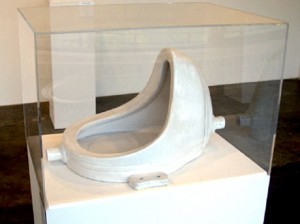In Cabinet Magazine, issue 27, there is an article titled Readymade Remade about Pierre Pinoncelli who first made a big name for himself by pissing in Marcel Duchamp’s readymade urinal. The article examines Pinoncelli’s argument that he was bringing history and value to the urinal by doing so. While the French gov’t did not agree with Pinoncelli at all, especially after Pinoncelli pissed in the same urinal again in 2006 — the article decidedly agrees with Pinoncelli. The writer, Leland de la Durantaye, smartly cites Duchamp himself as the authority — Duchamp, after “defacing” the Mona Lisa, claims that his Mona Lisa is not a readymade. Rather this remade Mona Lisa is an “assisted readymade”. By taking mass produced art and introducing “a unique commentary”, Duchamp means to bring this item back into the spectrum of art. With this, Durantaye implies that Pinoncelli is right in his claim that the French gov’t is wrong — but then after fining Pinoncelli, should the French gov’t pay him the money? After all, Pinoncelli’s “unique commentary” has increased the value of this French treasure by taking a mass produced readymade which has “lost [its] readymade authenticity, [its] unique identity, and [. . .] dynamically infus[ing] one of the replicas with [authenticity]”.

Twice stained, thrice as valuable. Look up Pierre Pinoncelli on the internet. You'll see he's quite a pissant. HA HA HA!!
Besides the “unique critique” of Duchamp’s work (of which Pinoncelli is a decidedly excited fan) there are three possible directions for contradictions:
1) Durantaye takes for granted the implication that what is valuable in art is expressed monetarily.
2) Benjamin’s famous essay on Art in the Age of Mechanical Reproduction equates uniqueness with art — that mass produced copies only accentuate the value of “originals” which the elite can then possess as being art. By unifying Duchamp’s readymade and his assisted readymade, Durantaye implies that Duchamp is not producing art at all — if a readymade meant to be art can be in need of “assistance” to rejoin the status of art then Duchamp is not at all an artist for Duchamp is not producing art.
3) Simultaneously, as you can imagine, Pinoncelli’s urine was cleaned from the “defaced” readymade. Nonetheless, Pinoncelli left, in the language of Lacan, an unseen stain, on that particular readymade. The British have recognized this readymade as being more intrinsically valuable. One of the subtexts of this article is that what is valuable is not necessarily tangible… that art itself has moved beyond the realm of pretty pictures and skillful techniques (for what kind of technique has Pinoncelli, besides the admirable ability to urinate in public before the eyes of others? — no doubt a feat most of us could not accomplish).
Taken all at once, although somewhat contradictory, we come across a paradox. Art then, in the contemporary age, is what both unique, intangible and monetarily valuable. Of course no matter what the French gov’t thought, they could not allow anyone pissing on any art. Imagine if they awarded Pinoncelli? What kind of people would go to the museums in the hopes of making “readymade” money? At once we see that art cannot be what is tangible. Of course, tangibility may be our best claim to any sort of possession of it. We go to museums to see art, but in fact run abut something else. So is art tangible?
If it is only tangible then Duchamp is not an artist. If it is intangible, then Duchamp and Pinoncelli are both artists. Durantaye sides with Pinoncelli and Pinoncelli with Duchamp.
But if art is not material, then what is art? If Duchamp is not an artist but a “materialist contextualist” then how are we to approach material context? We all understand that art can be horribly elitist, but is it so only in order to promote/protect its own value? Does this then make the lives of our celebrities art? What about expensive, corporate, buildings? What then happens to punk and the D.I.Y. culture? Is that no longer art but just noise (since anyone can punk)?
Again the direction seems to lie more with Deleuze and Guattari’s how more than the what. While both of these thinkers equate art with concept, if we take this discussion seriously it seems that art lies more with social positioning than anything else: architecture must be valuable because of the resources taken to produce it, as are museum housed works — and the millions of punk fans world-wide.
This bodes woe for fans of Kristeva, and all the art lovers around… as well as Deleuze and Guattari’s book What is Philosophy. But that’s the one book of theirs that I do not like. So that’s fine by me. (Any “commentary” I would like to share on that book? I think not, at least, I can’t comment if you’re watching…)
Me, personally? I don’t believe in any of what I just wrote anyhow.
Is that tangible enough for ya?